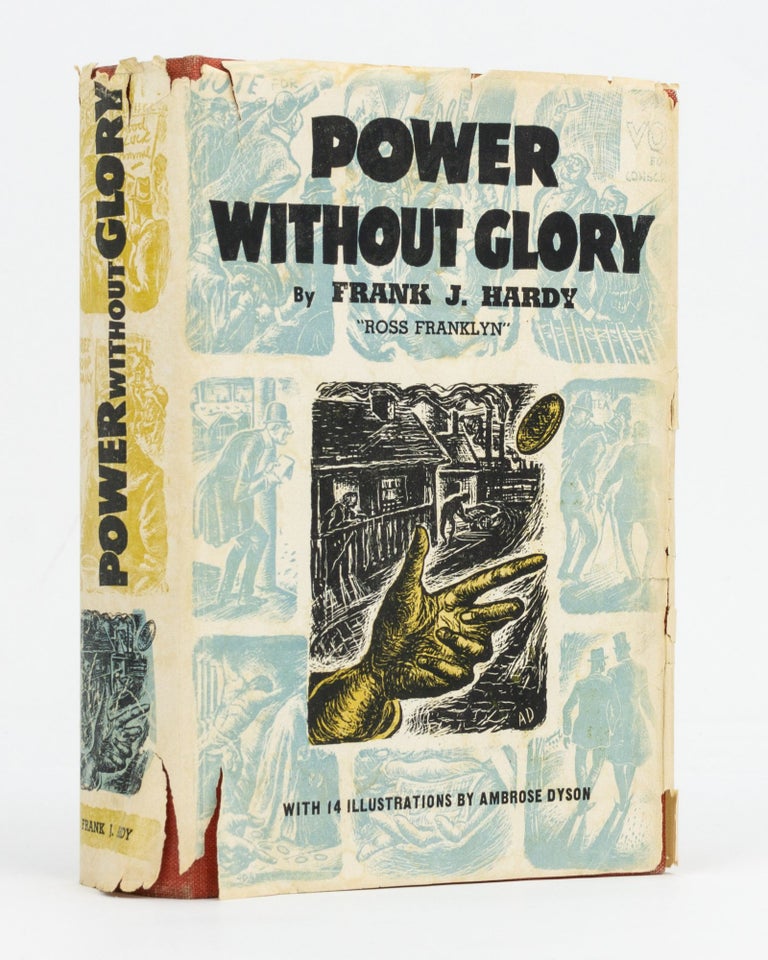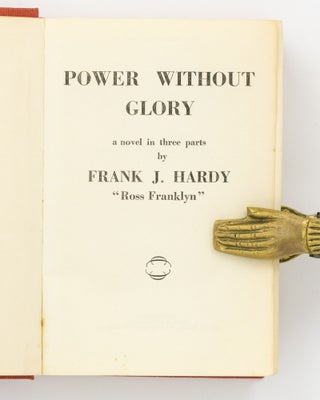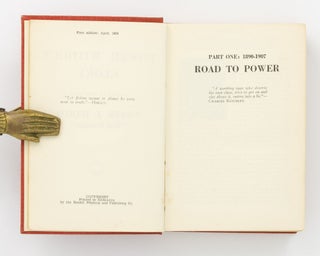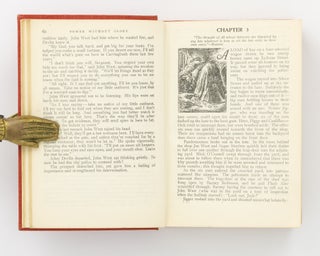Power without Glory. A Novel in Three Parts
Melbourne, Realist Printing and Publishing Co., April 1950 ('first edition', but in fact probably August 1950).
Octavo, 672 pages with 14 illustrated initials by Ambrose Dyson.
Original red cloth (lettered in black on the spine) a little bowed and rubbed; a few unobtrusive spots of foxing; a very good copy with the very good dustwrapper (featuring Dyson artwork) a little chipped and torn.
The first edition of this controversial novel. We can do no better than quote at length from the informative article by Des Cowley in 'The La Trobe Journal', Number 83, May 2009: 'The mystery surrounding the printing and publishing of Frank Hardy's "Power without Glory" has long been acknowledged. Hardy's novel, which traced the political and financial rise of Melbourne businessman and Labor Party supporter John West, was based on extensive research into the real-life John Wren. The fact that the book was supported by the Communist Party of Australia (CPA), and both critiqued the anti-communist activities of the Catholic Church and corruption within the Victorian Labor Party, meant that it was potentially explosive stuff. In the end, Hardy would find himself facing trial for the criminal libel of Ellen Wren, wife of John Wren, after having depicted her as having an adulterous affair in the novel. Hardy published his own account of the novel's production and subsequent trial in "The Hard Way" (1961). Writing about himself in the guise of his alter ego Ross Franklyn, Hardy states: "He knew that, just as no recognized publisher would touch the job with a forty-foot pole, none of the printeries would take it as an outside job. His plan was to do the printing himself and to have the other processes [ie. collating, binding] done in different places." One of the outcomes of Hardy's strategy to farm out these different processes was that few of those involved were party to the full narrative of the book's complex chain of production. This fact has only added to the book's mystery and notoriety. Hardy's own account is long on justification, but at times is frustratingly short on detail. It certainly downplays the key role that the Communist Party of Australia played in financially supporting the book from its earliest inception. More recently both Pauline Armstrong's book "Frank Hardy and the Making of 'Power without Glory'" (2000) and Jenny Hocking's "Frank Hardy: politics, literature, life" (2005) have done much to fill in the gaps left by Hardy's account. Between them, they have established as approximate a narrative timeline for the book's production as we are likely to get. It was in order to minimize CPA involvement that the decision was made that Hardy would organise the book's printing himself. To this end he set up the Realist Printing and Publishing Company. Printing of the first edition by Hardy, assisted by Ernie Bowles and Vic Little, both CPA printers, began around Christmas 1949, at Batten's Printery in Collins Street. Throughout, Hardy was ably assisted by George Seelaf, secretary of the Australasian Meat Industry Employees Union. The sixteen page metal formes that had been set by compositor Les Barnes at the CPA's Federal Press were delivered to Batten's and afterwards collected. As the printing of the thirty-two page sections - the standard unit of production - was completed, they were removed and stored for safe keeping at the houses of friends and CPA members. Because of the expense of the metal for typesetting the text, it was regularly melted and recycled throughout the process, with understandably little thought given to further editions. Collation, folding and binding of the first edition appears to have been carried out by a number of means, from commercial production through to the use of volunteers working in their homes. It is unclear how many copies of the first edition were produced by these means, but estimates place it at between 5,000-10,000 copies, a remarkable feat given the secretive and sporadic nature of the operation that stretched over a seven-month period. Certainly it is far from an uncommon book on the market today. Among its more striking features are the fourteen illustrated initials, contributed by Ambrose Dyson, which began each chapter and which are also used on the book's dustjacket. The first edition of "Power without Glory" is dated April 1950, but it seems more likely that it was early August 1950 before Hardy had substantial numbers of copies in a completed state ready for sale. This is partly borne out by the revision of the April date to August 1950 in the novel's second edition, by the book having been launched at the Melbourne Athenaeum in Collins Street on 3 August 1950, and by the first notices about it appearing in Melbourne newspapers that month. Though some copies found their way into bookshops, particularly those sympathetic to the CPA, by far the greater number was marketed via CPA networks and direct sales to trade unions and workers on the factory floor. So successful was this marketing that a second edition, dated October 1950, was issued to meet with demand. A third edition was printed in February 1951, and a fourth edition, the first in paperback form, in August 1951' (Des Cowley: 'Unique Copy or Clandestine Edition? The "Fraser" copy of Frank Hardy's "Power without Glory"', 'The La Trobe Journal', Number 83, May 2009, pages 91-100).
Item #93149
Sold




